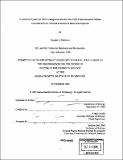| dc.contributor.advisor | Frank Gertler. | en_US |
| dc.contributor.author | Rubinson, Douglas A. (Douglas Adam), 1976- | en_US |
| dc.contributor.other | Massachusetts Institute of Technology. Dept. of Biology. | en_US |
| dc.date.accessioned | 2006-07-31T15:30:49Z | |
| dc.date.available | 2006-07-31T15:30:49Z | |
| dc.date.copyright | 2005 | en_US |
| dc.date.issued | 2005 | en_US |
| dc.identifier.uri | http://hdl.handle.net/1721.1/33754 | |
| dc.description | Thesis (Ph. D.)--Massachusetts Institute of Technology, Dept. of Biology, 2005. | en_US |
| dc.description | Vita. | en_US |
| dc.description | Includes bibliographical references. | en_US |
| dc.description.abstract | Mammalian development extends and exploits signaling pathways that function exclusively in axon guidance in lower organisms. This emerging paradigm employs complex expression patterns of expanded protein families to achieve the complexity and specificity required in mammalian development. For example, the Drosophila axon guidance ligands, Netrin and Slit, have recently been implicated in the development of several mammalian organ systems. While the characterization of extra-neuronal functions of ligands and receptors has emerged, the conservation of intracellular signaling pathways remains unclear. The Ena/VASP protein family is a common downstream effector of multiple axon guidance signaling cascades. The analysis of the Ena/VASP triple-null mouse allows us to determine the extent to which these intracellular cascades have been conserved in the development of the mammalian nervous system as well as other organs. Within the nervous system, we have uncovered novel roles for Ena/VASP in the initiation of axon extension, guidance of non-commissural axons, and neuronal migration. Outside the nervous system, we have observed a novel role for Ena/VASP in blood vessel physiology. | en_US |
| dc.description.abstract | (cont.) Interestingly, several developmental pathways for which axon guidance receptors have been implicated appear to develop normally in Ena/VASP triple-null embryos. Future work in Ena/VASP developmental biology will analyze the specific roles of Ena/VASP splice isoforms and unique functions of individual Ena/VASP family members. I have developed a lentiviral system for the creation of mouse transgenics including RNAi knockdowns that can be applied to address these questions. | en_US |
| dc.description.statementofresponsibility | by Douglas A. Rubinson. | en_US |
| dc.format.extent | 239 p. | en_US |
| dc.format.extent | 13899067 bytes | |
| dc.format.extent | 13909177 bytes | |
| dc.format.mimetype | application/pdf | |
| dc.format.mimetype | application/pdf | |
| dc.language.iso | eng | en_US |
| dc.publisher | Massachusetts Institute of Technology | en_US |
| dc.rights | M.I.T. theses are protected by copyright. They may be viewed from this source for any purpose, but reproduction or distribution in any format is prohibited without written permission. See provided URL for inquiries about permission. | en_US |
| dc.rights.uri | http://dspace.mit.edu/handle/1721.1/7582 | |
| dc.subject | Biology. | en_US |
| dc.title | A lentiviral system for RNAi transgenesis and the Ena/VASP triple-knockout defines neuronal and non-neuronal functions in mouse development | en_US |
| dc.type | Thesis | en_US |
| dc.description.degree | Ph.D. | en_US |
| dc.contributor.department | Massachusetts Institute of Technology. Department of Biology | |
| dc.identifier.oclc | 65196871 | en_US |
